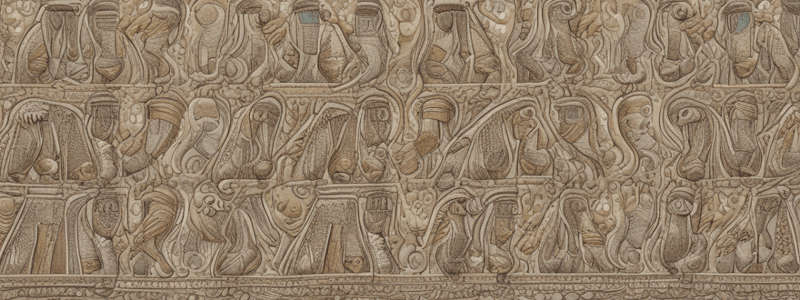Podcast
Questions and Answers
What is Muga silk?
What is Muga silk?
- A fabric made in Japan
- A fabric made in China
- A fabric made in India (correct)
- A fabric made in Thailand
What is the source of Muga silk?
What is the source of Muga silk?
- Silkworms (correct)
- Cotton plants
- Sheep wool
- Synthetic fibers
Why is Muga silk so expensive?
Why is Muga silk so expensive?
- Due to its limited supply (correct)
- Due to its low quality
- Due to its easy production process
- Due to its abundance
What is threatening the muga silkworms?
What is threatening the muga silkworms?
What is selvage denim?
What is selvage denim?
How does Momotaro dye their threads?
How does Momotaro dye their threads?
Why is natural indigo more expensive than synthetic indigo?
Why is natural indigo more expensive than synthetic indigo?
Why is Japanese denim more expensive than regular denim?
Why is Japanese denim more expensive than regular denim?
What is Lever's lace?
What is Lever's lace?
Why is French lace production declining?
Why is French lace production declining?
What are kimonos?
What are kimonos?
What is the most expensive textile in the world?
What is the most expensive textile in the world?
Flashcards are hidden until you start studying
Study Notes
- Muga silk is a unique fabric that can only be made in the Assam region of India.
- The naturally golden fabric comes from the cocoon of muga silkworms and requires a labor-intensive process to produce.
- Muga silk can cost up to $6,500 per sari due to its limited supply and expensive production process.
- The muga silkworms are threatened by climate change and exposure to harmful chemicals used in tea gardens.
- Japanese denim, particularly selvage denim, is made on old shuttle looms and has a sealed edge to prevent fraying.
- Momotaro, a well-known Japanese denim brand, hand-dyes their threads with natural indigo, which is a time-consuming and expensive process.
- Natural indigo can cost 10 times more than synthetic indigo and is only enough to dye about 15 pairs of jeans per bail.
- Japanese denim is woven on slower, automated looms that require close attention from skilled technicians.
- The high cost of muga silk and Japanese denim is due to their limited supply, expensive production processes, and unique qualities.
- Environmental conservation efforts are needed to ensure the survival of muga silkworms and the production of muga silk.
- Momotaro jeans are made using traditional methods, such as hand-weaving and hand-stitching.
- Japanese denim is considered one of the finest types of denim in the world, but it is more expensive due to the artisanal nature of its production.
- Lever's lace is a complex and intricate fabric that is made using century-old looms and requires a team of skilled artisans to produce.
- Lever's lace is more expensive than mass-produced lace due to the complexity of its production and the limited availability of the looms used to make it.
- French lace production has declined in recent years due to competition from cheaper lace manufacturers and changes in fashion trends.
- Kimonos are a traditional Japanese garment worn on special occasions, and handmade kimonos can cost tens of thousands of dollars.
- The production of traditional textiles and garments requires a team of skilled artisans and a significant amount of time and effort.
- The high cost of artisanal production is due to the precision and attention to detail required at every step of the process.
- The artisanal production of textiles and garments is a dying art form, as younger generations are less interested in pursuing these trades.
- The COVID-19 pandemic has had a significant impact on the textile and garment industry, making it even more challenging to maintain traditional production methods.
- Chiso collaborates with skilled artisans to create intricate kimonos made entirely out of silk.
- Each kimono takes around 12 meters of silk and can take 6 to 12 months to make.
- The design process involves drafting, painting, dyeing, and embroidery, with some designs costing over $100,000.
- The relevance of the kimono in modern life is limited, and the industry has declined since the 90s.
- Vicuña wool is the most expensive textile in the world, with a single kilogram selling for $370.
- Vicuñas cannot be domesticated and are difficult to come by, but conservation efforts have helped the herd grow.
- The ultra-fine fur of vicuña wool is what makes it so expensive.
- The process of capturing and shearing the vicuñas is carefully managed to ensure conservation and quality of the wool.
- The hurting of vicuñas is an essential way of life for communities in Northern Bolivia.
- Technical managers oversee communities to ensure they are equipped to produce the best possible product and get the best price for their yield.
Studying That Suits You
Use AI to generate personalized quizzes and flashcards to suit your learning preferences.




